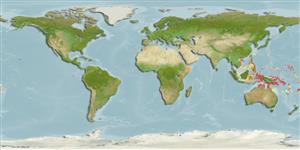>
Gobiiformes (Gobies) >
Gobiidae (Gobies) > Gobiinae
Etymology: Trimma: Greek, trimma, -atos = something crushed (Ref. 45335); pajama: Name from the Hindi word 'pajama', a loose clothing worn when retiring for the night, alluding to the contrasting stripes so common in at least the British version of that garment; noun in apposition..
Environment: milieu / climate zone / depth range / distribution range
Ekologi
laut berasosiasi dengan karang; kisaran kedalaman 3 - 10 m (Ref. 96671). Tropical
Western Pacific: Indonesia and Papua New Guinea, with photographs and specimens from the Solomon Is. and Palau (Ref. 96671); and Tonga (Ref. 90102).
Size / Weight / umur
Maturity: Lm ? range ? - ? cm
Max length : 1.6 cm SL (female)
deskripsi pendek
Morfologi | Morfometrik
Duri punggung (Keseluruhan (total)): 7; duri punggung lunak (Keseluruhan (total)): 8; Duri dubur 1; Sirip dubur lunak: 8. This species is distinguished by the following characters: predorsal midline with 6 scales; 2 ctenoid scales along the upper border of the opercle; cheek scaleless; first 2 dorsal spines slightly elongated and reaching posteriorly to between the base of the spine and the base of the first ray of the second dorsal fin; unbranched pectoral-fin rays; a fifth pelvic fin ray which branches once dichotomously and is 58-72% the length of the fourth ray; full basal membrane connecting the inner margins of the fifth pelvic fins rays in undamaged specimens; live colour pattern of red-orange and dark brown or grey stripes on the body reaching posteriorly to the anterior half of the caudal peduncle, it is unique among members of the genus, as is the preserved colour pattern of dark and light body stripes (Ref. 96671).
This species appears to be restricted to relatively shallow (3-10 m) reef areas protected from wave
exposure. Type specimens were collected exclusively from within beds of Halimeda macroalgae growing beneath branching Acropora coral stands. It is apparently the only species of the genus to be limited to this habitat (Ref. 96671).
Life cycle and mating behavior
Kematangan | Reproduksi, perkembang biakan | Pemijahan | telur-telur | Fecundity | Larva
Winterbottom, R., M.V. Erdmann and N.K.D. Cahyani, 2014. Three new species of Trimma (Pisces; Gobioidei) from Indonesia. Zootaxa 3838(3):367-384. (Ref. 96671)
Status IUCN Red List (Ref. 130435)
ancaman kepada manusia
Harmless
penggunaan manusia
informasi lanjut
Nama-nama umumSinonim (persamaan)metabolismePemangsaEkotoksikologiReproduksi, perkembang biakanKematanganPemijahanSpawning aggregationFecunditytelur-telurpekembangan telor
Umur / SaizPertumbuhanpanjang-beratpanjang-panjangukuran frekuensiMorfometrikMorfologiLarvaDinamika larvapemulihanKelimpahanBRUVS
AcuanBudidaya airprofil budidaya airStrainGenetikaElectrophoresesDiturunkanPenyakit-penyakitPengolahanNutrientsMass conversion
mitraGambarStamps, Coins Misc.Suara-suaraCiguateraKecepatanTipe renangArea insangOtolithsOtakPenglihatan / visi
Alat, peralatan
laporan khas
muat turun XML
Sumber internet
Estimates based on models
Preferred temperature (Ref.
123201): 27.5 - 29.4, mean 28.8 °C (based on 999 cells).
Phylogenetic diversity index (Ref.
82804): PD
50 = 0.5000 [Uniqueness, from 0.5 = low to 2.0 = high].
Bayesian length-weight: a=0.01023 (0.00477 - 0.02194), b=3.02 (2.84 - 3.20), in cm total length, based on LWR estimates for this (Sub)family-body shape (Ref.
93245).
Daya lenting (Ref.
120179): Tinggi, Waktu penggandaan populasi minimum kurang dari 15 bulan (Preliminary K or Fecundity.).
Fishing Vulnerability (Ref.
59153): Low vulnerability (10 of 100).
